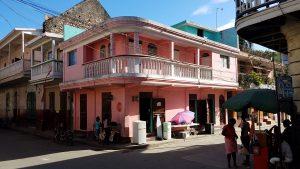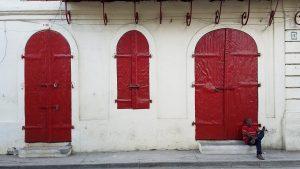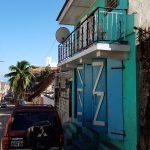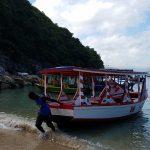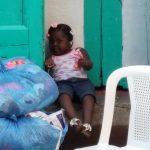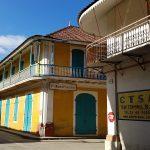I’ve been in Port au Prince for five days now, it’s time for a change of pace. I climb into the rinky-dink turboprop to Cap Haitien, a mid-size town on the northern coast of Haiti. It’s a bumpy 30-minute flight but it sure beats the 7-hour bus drive over rough terrain and potholed roads (at least so I’m told.) Cap Haitien is of particular consequence in the story of Haiti. It is the original colonial capital, known to French occupiers as the Paris of the Antilles. The slave rebellion started here in the early 1790s and spread to the rest of the island. It is also the place where voodoo started. Most people here are officially catholic, but it’s hard to break with old traditions. “We don’t worship voodoo but it is our principal and our master,” so tells me a Haitian. Who am I to disagree?
Cap Haitien lies on a large bay, not far from where Columbus landed on his first voyage. It’s ironic that I write this post on Christmas day. It is this very same day in 1492 that Columbus’s flagship, the Santa Maria, beached a few miles to the north of here. At this location, he decided to build his first colony, fittingly called La Navidad. The settlement did not last long and soon disappeared, lost to history for five centuries. Remnants of it were rediscovered only in 1972. Unfortunately, the savagery of Columbus and his fellow Spaniards ensured that the Taino people, the natives who originally populated this land, also disappeared to history. Unlike a lost colony, the Taino can never be brought back.
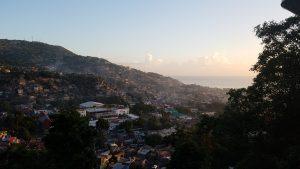
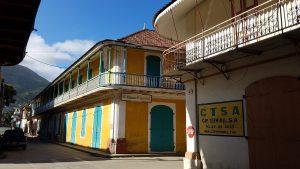
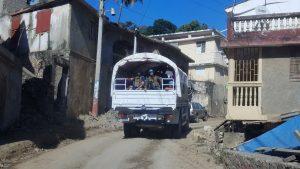
I make my residence at Habitation des Lauriers, a gorgeous colonial-style villa on a hill top overlooking the bay. If you squint, you can see the Dominican Republic from here. The family that runs the inn, as colorful and diverse as the streets below, has owned this property since the 1970s. Seeing a pent-up demand for quality tourist accommodations, Brenda and Leslie decided to trade their quiet lives in South Carolina for a far more interesting life hosting travelers to Haiti. With the help of their two adult sons, Pablo and James, the property has been gradually taking in more and more tourists. They are even in the process of building dormitories to accommodate backpackers. The next morning, Pablo assures me, he will take me to the best place in all of Haiti.
Navigating his truck up steep and winding hills, the rugged road seems to never end. We are on our way to the islands of northern Haiti, to see the country in its raw beauty. Little sheds along the side of the road reveal children running along. Heavily malnourished dogs, dirty, mangy and flea-ridden, trod along the side of the road. They compete with the local goat population for scraps of food and waste. The dirt roads are heavily worn and bumpy, but Pablo swears to me that they are better today than in the past. The government is paving the way for more tourists to visit. A hopeful sign for Haiti?
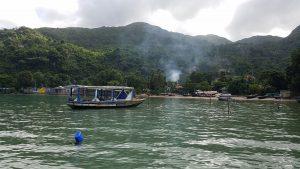
We continue on to our destination. I rest on the bow of the boat, the waves gently rocking us up and down, my feet dangling below, gliding through the warm Caribbean waters. Several kilometers out to see and we slow down to inspect the catch of a local fisherman. It looks good! We buy some fish, a couple of lobster and some bread fruit before continuing on our merry way. The sun beats overhead, I watch the gorgeous coastline float by. The steep ridges of mountains rise up straight from the water to a couple hundred meters in some cases, covered in dense, green, and lush tropical forest. This is the same view Columbus would have had some five centuries earlier. It’s Christmas day after all, he would have sailed this very same water on this very same date. Oh history, you are full of irony. To quote Lord Acton, “history is not a burden on our memory but an illumination on the soul.”
A while on and we’re still skirting the coast line. What’s that yellow beast popping out of the water over there, I inquire with Pablo. He just grins. No way, is that a tiny sand bank? It is, no more than 3 meters wide and about 6 meters long. We drop anchor and I joyously hop out. Here I am, several kilometers out to sea, surrounded by nothing but water, and I’m wading in water barely deep enough to reach up to my ankles! “Are you kidding me?!” I exclaim. But this is no joke. This is the simple beauty of Haiti. Pablo laughs, “I knew you would enjoy this!” Well played, Pablo, well played.
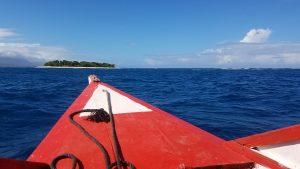
Our destination, a remote island off the coast of Haiti
Arriving back in Cap Haitien, I reflect upon the physical and emotional beauty of this day. The music still emanates from the streets, the people have not stopped celebrating. Is this a dream, I wonder again? No, it’ not a dream. This is a fairy tale.
To wit, I shall leave you with Columbus’ description of what he saw when he first arrived. Genocidal pirate or not, his description of the island of Hispaniola is still accurate today:
“Groves of lofty and flourishing trees are abundant, as also large lakes, surrounded and overhung by the foliage, in a most enchanting manner. Everything looked as green as in April in Andalusia. The melody of the birds was so exquisite that one was never willing to part from the spot, and the flocks of parrots obscured the heavens. The diversity in the appearance of the feathered tribe from those of our country is extremely curious. A thousand different sorts of trees, with their fruit were to be met with, and of a wonderfully delicious odor.” – Christopher Columbus, 1492
[Author’s note: all photos taken by me]
